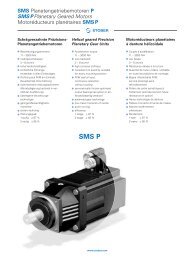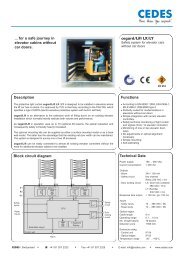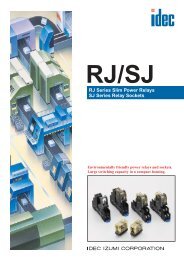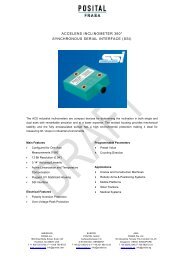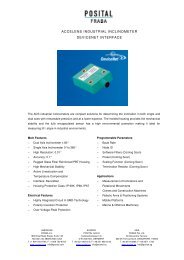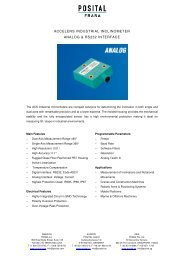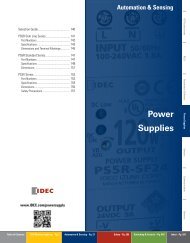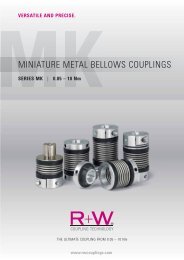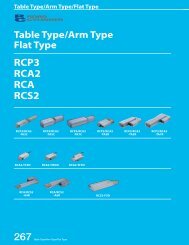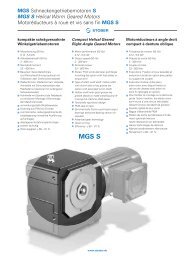Create successful ePaper yourself
Turn your PDF publications into a flip-book with our unique Google optimized e-Paper software.
<strong>HS6E</strong> Subminiature Interlock Switches with Solenoid<br />
Safety Precautions<br />
• In order to avoid electric shock or fire, turn power off before<br />
installation, removal, wiring, maintenance, or inspection of<br />
the interlock switch.<br />
• If relays are used in the circuit between the interlock switch<br />
and the load, use only safety relays, since welded or sticking<br />
contacts of standard relays may invalidate the functions<br />
of the interlock switch. Perform a risk assessment and<br />
make a safety circuit which satisfies the requirements of<br />
the safety category.<br />
• Do not place a PLC in the circuit between the interlock<br />
switch and the load. Safety security can be endangered in<br />
the event of a malfunction of the PLC.<br />
• Do not disassemble or modify the interlock switch, otherwise<br />
a malfunction or an accident may occur.<br />
• Do not install the actuator in a location where a human<br />
body may come in contact. Otherwise injury may occur.<br />
• Solenoid lock type is locked when energized, and unlocked<br />
when de-energized. When energization is interrupted due<br />
to wire disconnection or other failures, the interlock switch<br />
may be unlocked causing possible danger to the operators.<br />
Solenoid lock type must not be used in applications where<br />
locking is strictly required for safety. Perform a risk assessment<br />
and determine whether solenoid lock type is appropriate.<br />
Instructions<br />
• Regardless of door types, do not use the interlock switch<br />
as a door stop. Install a mechanical door stop at the end of<br />
the door to protect the interlock switch against excessive<br />
force.<br />
• Do not apply external force on the actuator while<br />
unlocking, otherwise the actuator may not be unlocked.<br />
• Do not apply excessive shock to the interlock switch when<br />
opening or closing the door. A shock to the interlock switch<br />
exceeding 1,000 m/s 2 may cause damage to the interlock<br />
switch.<br />
• If the operating atmosphere is contaminated, use a<br />
protective cover to prevent the entry of foreign objects into<br />
the interlock switch through the actuator entry slots.<br />
• Entry of a considerable amount of foreign objects into the<br />
interlock switch may affect the mechanism of the interlock<br />
switch and cause a malfunction.<br />
• Do not store the interlock switches in a dusty, humid, or<br />
organic-gas atmosphere, or in an area subjected to direct<br />
sunlight.<br />
• Use proprietary actuators only. When other actuators are<br />
used, the interlock switch may be damaged.<br />
• The locking strength is rated at 500N. Do not apply a load<br />
higher than the rated value. When a higher load is<br />
expected, provide an additional system consisting of<br />
another interlock switch without lock (such as the <strong>HS6B</strong>/<br />
HS7A interlock switch) or a sensor to detect door opening<br />
and stop the machine.<br />
• Regardless of door types, do not use the interlock switch<br />
as a door lock. Install a separate lock using a latch or other<br />
measures.<br />
• While the solenoid is energized, the switch temperature<br />
rises approximately 35°C above the ambient temperature<br />
(to approximately 85°C while the ambient temperature is<br />
50°C). Do not touch to prevent burns. If cables come into<br />
contact with the switch, use heat-resistant cables.<br />
• Bouncing will occur on the lock monitor contact during<br />
locking and unlocking (reference value: 20 ms).<br />
• Although the HS9Z-A61/A62/A62S actuators alleviate<br />
shock when the actuator enters a slot in the interlock<br />
switch, make sure that excessive shock is not applied.<br />
If the rubber bushings become deformed or cracked,<br />
replace with new ones.<br />
Minimum Radius of Hinged Door<br />
• When using the interlock switch on hinged doors, refer to<br />
the minimum radius of doors shown below. When using on<br />
doors with small minimum radius, use the angle adjustable<br />
actuator (HS9Z-A65 and HS9Z-A66).<br />
Note: Because deviation or dislocation of hinged doors may occur<br />
in actual applications, make sure of the correct operation<br />
before installation.<br />
When using the HS9Z-A62/A62S Right-angle Actuator<br />
• When the door hinge is on the extension line of the interlock switch<br />
surface:<br />
Minimum Radius<br />
160 mm<br />
Door Hinge<br />
Minimum Radius<br />
160 mm<br />
Door Hinge<br />
• When the door hinge is on the extension line of the interlock switch<br />
surface:<br />
Minimum Radius<br />
230 mm<br />
Door Hinge<br />
Minimum Radius<br />
230 mm<br />
Door Hinge<br />
(07/03/16)<br />
13




